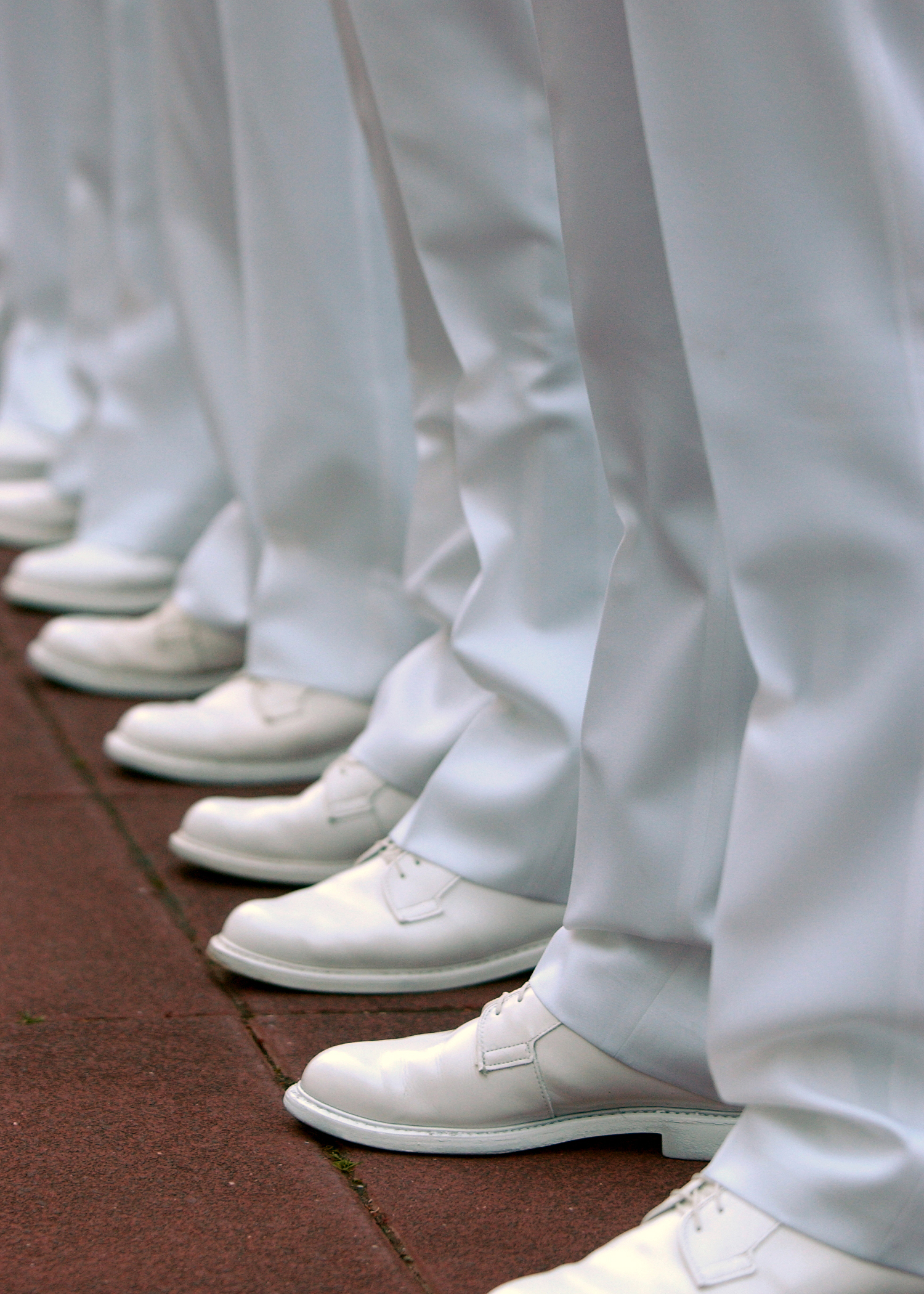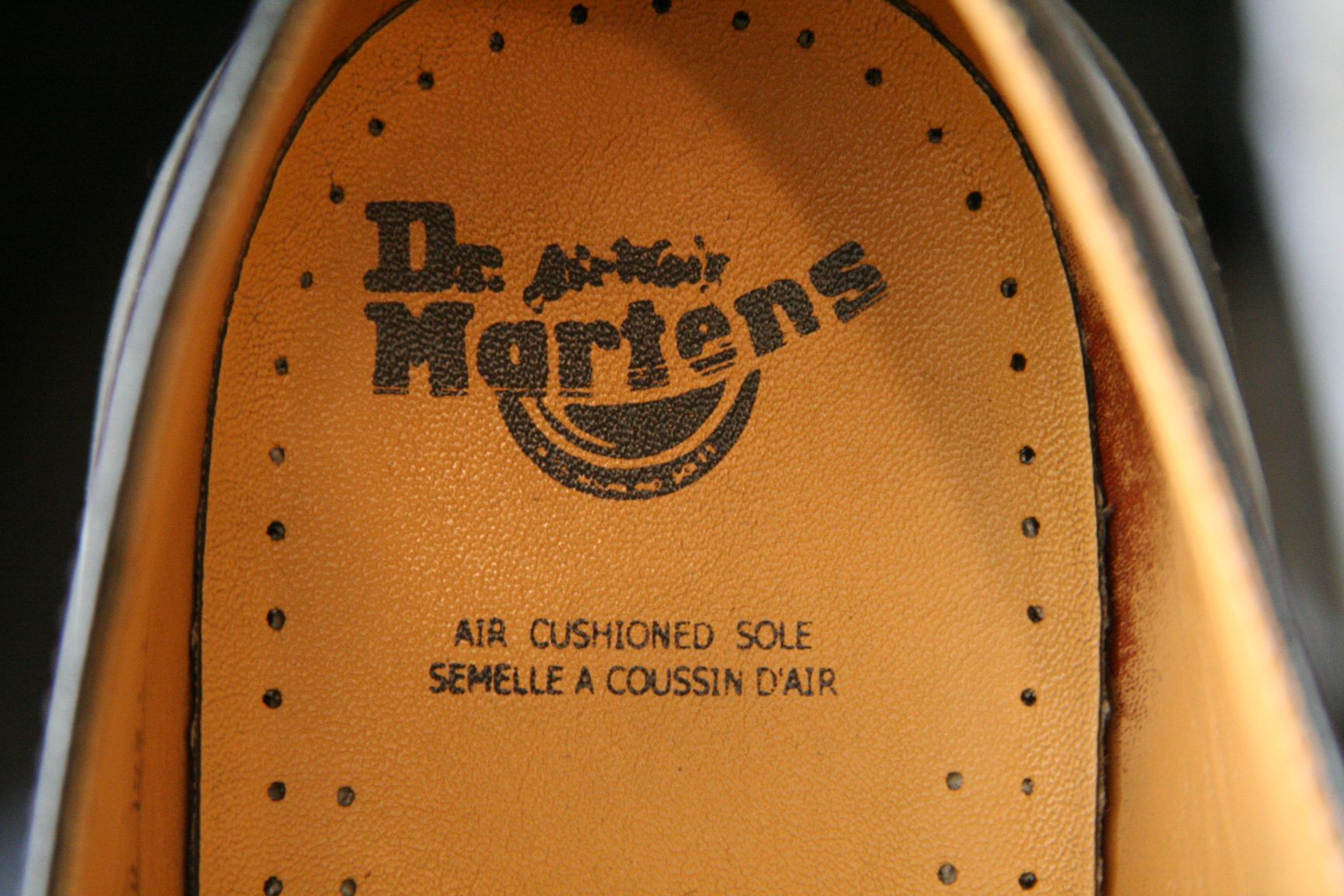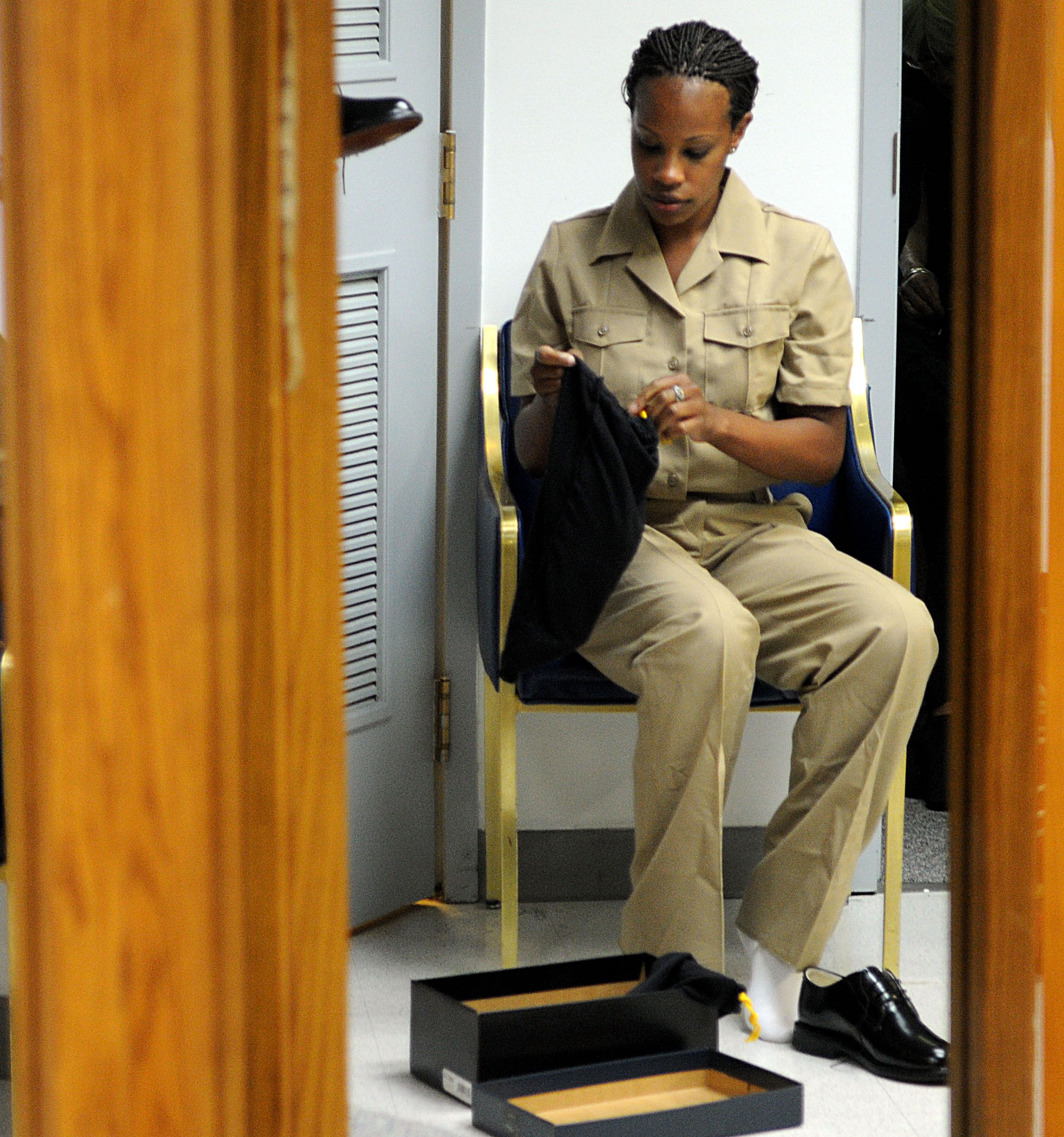
Just days away from her second son’s due date, uncomfortable in an ill-fitting pregnancy uniform, Lt. Cmdr. Lauren Hanzel, had no idea her pair of black Bates Oxford-style shoes were about to fail during an awards ceremony.
Hanzel hadn’t noticed anything amiss with her shoes, only a couple of years old and carefully stored in a closet when not worn. While she was so pregnant she couldn’t directly see her feet, there was no mistaking where the sad trail of shoe led.
“I’m not sure anyone noticed, like the civilians, but I knew it was me,” Hanzel said. “The shoes were not very old and I hadn’t worn them for the entire tour.”
For years disintegrating Bates uniform shoes have been the scourge of formal events, standing watch, awards, and promotion and retirement ceremonies. Sailors like Hanzel have shared their frustrations with friends and colleagues, dubbing the phenomenon “Bates Blowout,” on social media sites like Facebook, Reddit and Instagram (search: #Batesblowout).
Now, with promotion season in full swing and the fall uniform shift a couple weeks off, online forums are giving a louder voice to sailors fed up with the expense of replacing shoes they’ve only worn a couple of times, and eagerly seeking alternatives, including Dr. Martens, the Goodyear-welted shoes adored for decades by the punk rock set.
Anatomy of a Blowout

When a Bates blowout occurs, the process isn’t instantaneous; rather the polyurethane used to make the outer sole starts crumbling, bit by bit with each step.
Stories litter social media with embarrassing tales of leaving shoe chunks on the deck of important events. In Hanzel’s case, she was inside the Kitsap County Courthouse receiving the local bar association’s Outstanding Navy League Professional Award.
Sailors have tried electrical tape and glue to stave off disaster, but once a blowout starts there’s no stopping it; the battle to save a Bates sole was lost before it was taken out of storage.
The reason is simple: air.
The dry confines of storerooms, closets and shoeboxes are the exact wrong environment for polyurethane to remain flexible, shoe experts says. Yet dress uniform shoes spend most of their lives in such spaces, making polyurethane probably the worst material to use in these types of shoes, shoe expert Phillip Nutt, of Toronto-based Wenco International Footwear Consultants told USNI News.
Upon close inspection, the polyurethane typically used to make shoe outer soles is not a solid block. It’s sponge-like, with tiny air pockets and water mixed in, Nutt said. The soles crumble due to oxidation. Water mixes with the polyurethane compound when it’s created. Over time, this water seeps out or evaporates, leaving behind a more rigid, arid, brittle material that easily crumbles.
Oxidation is a problem for the shoes, agreed Andrew Fowler, vice president and general manager for Bates. Storing them for long periods is the wrong way to use Bates, he told USNI News. Keeping Bates shut in a box or closet for months at a time is the same thing that happens to a rubber band in a desk drawer: If left too long, it becomes brittle, losing elasticity and eventually crumbles.
“They’re made to be worn,” Fowler said. “The polyurethane we use has a shelf life of eight to ten years. It’s not a defect. It’s just polyurethane material has a shelf life.”
And the clock on polyurethane’s shelf life starts ticking the moment the compound is mixed. Fowler said the most common uniform shoe sizes sold – men’s 9, 10 and 11 – only sit in the assembly plant for a couple of months, then at the Navy Exchange for at most a couple months more. However, less common sizes — like smaller women’s and larger men’s — could be much older, Fowler said
Fowler has heard blowout stories and sent USNI News the company’s standard response: Bates changed the formula used to make their polyurethane outer soles in 2009 to make their shoes more durable.
“We worked with the Navy and they have a protocol to purge their inventory of footwear,” Fowler said. “[Between] that, and the reality of the chemical change, sailors should feel very good about the shoes they buy today.”
The Navy Exchange hasn’t carried Bates made with the old formula for years and relatively few pairs of Bates shoes are returned to the Navy Exchange because of crumbling soles, said Courtney L. Carrow, Public Affairs Officer with the Navy Exchange Service Command.
But based on the way sailors use their uniform shoes, which generally means storing them for extended periods of time, Nutt faults Bates for not updating its production process more. There’s better technology used by other shoe manufacturers to stave off soles’ crumbling.
The blowout phenomenon isn’t confined to Bates. Athletic shoe makers noticed this problem years ago and have worked to create solutions, Nutt said. The Adidas Boost, he said, uses a polyurethane pellet created by BASF to prevent oxidation.
Polyurethane can be made durable, he said. After all, the compound was originally developed for use by tire manufacturers, though it proved too slippery for the roads. Durability was never the problem.
“The Bates technology is outdated,” Nutt said.
Stepping On Bates’ Bottom Line

Dr. Martens – the iconic punk rock shoemaker of the anti-establishment– is attracting more officers and enlisted sailors willing to bend the established uniform rules to avoid a blowout.
But Dr. Martens does something many other shoemakers don’t: manufacture Oxford-style shoes close enough to meet uniform standards and accommodate smaller women’s shoe sizes, including all-white shoes.
While stories of officers and enlisted adopting Doc Martens are still too anecdotal to quantify, the trend could step on the bottom line of Bates and parent Wolverine Worldwide.
Bates has a captive military customer base. The brand isn’t required for dress shoes, but the Navy Exchange uniform store carries Bates brand Oxfords, currently retailing for $90.98. Annually, the Navy Exchange sells about 60,000 pairs of Bates, Carrow said.
Dr. Martens, owned by London-based private equity firm Primera, does not release sales information. Sara LaHaie, the company’s North America spokeswoman, was bemused when informed sailors are using Dr. Martens as a uniform shoe. She wouldn’t release specific details about model sales, but did tell USNI News, “We have been making the all white and the all black version for a few seasons now and [it] is a very good seller for us all around.”

Wolverine Worldwide has counted on Bates to hold the line for its Heritage Shoe Division. While other division brands, such as the Harley-Davidson branded motorcycle boots, and the Wolverine and HyTest workboots have suffered through years of lower demand, the company reported Bates prevented the division’s sales decline from being worse.
The division’s sales decreased by $23.5 million between 2015 and 2016, representing a 6.3 percent drop. But Wolverine reported this sales decrease was, “partially offset by mid-teens (sales) growth from Bates.”
In 2015, the division’s revenue increased by a modest $800,000, or 0.2 percent when compared to 2014 totals. The slight revenue increase was the result of mid single-digit growth from Bates.”
But the threat posed by online petitions, unflattering social media coverage and a viable alternative is real. Wolverine Worldwide’s annual report concedes that it could negatively affect the company’s bottom line.
“The company’s success depends in part on its brands’ images. If the company is unable to timely and appropriately respond to changing consumer preferences and evolving footwear and apparel trends, the names and images of its brands may be impaired. If the company fails to react appropriately to changes in consumer preferences, consumers may consider its brands’ images to be outdated or associate its brands with styles that are no longer popular. Such failures could result in substantial unsold inventory and adversely affect the company’s operating results.”
When complaints come to Bates, Fowler said the company does refer customers to the Navy Exchange, but also tries to find a solution, including sending replacement shoes.
“It’s a complicated message to communicate,” Fowler said.
Battling the negative reviews, comments, and impressions among active duty, reservists, and retirees isn’t easy. Even the Bates corporate website has negative reviews. One post on the Bates site shared a fairly typical scenario, stating, “I am retired USN and participated in a retirement ceremony and wore my Bates Lites (less than 4 years old and only worn three times). In the middle of the ceremony, the soles of my shoes began to come apart and crumble. I had the same issue about 10 years ago when I was on active duty. Shame on me for trusting your shoes over the years!!”
Or as one person ominously posted on Reddit, “If you have never had a Bates blowout you will. I promise. Furthermore will likely be right before an inspection, or someplace where you cannot deal with it (like at the USS Arizona Memorial?)”
What to Do?

The Navy Uniform Matters Office considers useful wear-life of a shoe to be 36 months and the Navy Exchange recommends replacing shoes that often, Carrow said.
For sailors looking to purchase uniform shoes, Nutt recommends only buying rubber soled shoes — something with a Goodyear-welt.
“The rubber outsoles will last longer,” Fowler said. “The benefit of polyurethane,” Fowler said, “is it’s lighter, more flexible, and intended to be more comfortable.”
Bates makes rubber soled uniform shoes which are sold in the Navy Exchange. These are also the shoes issued to sailors, and part of government contracts to purchase uniform footwear. But longevity, Fowler said, comes with a cost: comfort.
For instance, following the United States Naval Academy’s football team 2016 loss to archrival football team from the United States Military Academy, Navy’s coaching staff started looking at possible causes of the season’s spate of foot injuries. The coaching and training staff was concerned the Navy football players were wearing the same pair of Bates Oxford-style uniform issued to their first year at the academy, according to a story reported by The Washington Post. Players are now regularly required to bring their Oxford-style uniform shoes to a cobbler on the academy grounds and do special foot exercises before practice and games.
As for Hanzel, she laughs now about her Bates blowout but is still annoyed by the occurrence. She’s currently transitioning from active duty to the Navy reserves, and hasn’t decided what to do about her uniform shoes which will get even less use. She’s heard about the Dr. Martens option, but isn’t satisfied “the shoe solution is to get non-uniform shoes.”
“Their mission in life is to make shoes,” Hanzel said of Bates. “They can do better. We deserve better.”





